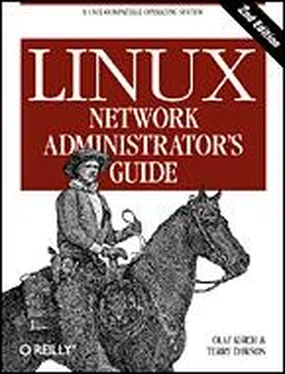We'll use the nntpsend command to transport the news via NNTP to the news.groucho.edu server. nntpsend requires us to use the "file" delivery method and to write the article's pathname and article ID. Note that we've set the param field to the name of the output file. We'll talk a little more about the nntpsend command in a moment. Our resulting newsfeed's configuration is:
# /etc/news/newsfeeds file for the Virtual Brewery
#
# Send all newsgroups except the control and junk ones by default
ME:!control,!junk::
#
# Generate overview data for any newsreaders to use.
overview::Tc,WO:/usr/lib/news/bin/overchan
#
# Feed the Groucho Marx University everything except our private newsgroup
# and any articles posted to the rec.crafts.brewing.poison newsgroup.
gmarxu:!rec.crafts.brewing.poison,@rec.crafts.brewing.private:\
Tf,Wnm:news.groucho.edu
#
The nntpsend program manages the transmission of news articles using the NNTP protocol by calling the innxmit command. We saw a simple use of the nntpsend command earlier, but it too has a configuration file that provides us with some flexibility in how we configure our news feeds.
The nntpsend command expects to find batch files for the sites it will feed. It expects those batch files to be named /var/spool/news/out.going/sitename . innd creates these batch files when acting on an entry in the newsfeeds , which we saw in the previous sections. We specified the sitename as the filename in the param field, and that satisfies the nntpsend command's input requirements.
The nntpsend command has a configuration file called nntpsend.ctl that is usually stored in the /etc/news/ directory.
The nntpsend.ctl file allows us to associate a fully qualified domain name, some news feed size constraints, and a number of transmission parameters with a news feed site name. The sitename is a means of uniquely identifying a logical feed of articles. The general format of the file is:
sitename:fqdn:max_size:[args]
The following list describes the elements of this format:
sitename
The sitename as supplied in the newsfeeds file
fqdn
The fully qualified domain name of the news server to which we will be feeding the news articles
max_size
The maximum volume of news to feed in any single transfer
args
Additional arguments to pass to the innxmit command
Our sample configuration requires a very simple nntpsend.ctl file. We have only one news feed. We'll restrict the feed to a maximum of 2 MB of traffic and we'll pass an argument to the innxmit that sets a 3-minute (180 second) timeout. If we were a larger site and had many news feeds, we'd simply create new entries for each new feed site that looked much the same as this one:
# /etc/news/nntpsend.ctl
#
gmarxu:news.groucho.edu:2m:-t 180
#
Controlling Newsreader Access
Not so many years ago, it was common for organizations to provide public access to their news servers. Today it is difficult to locate public news servers; most organizations carefully control who has access to their servers, typically restricting access to users supported on their network. INN provides configuration files to control this access.
We mentioned in our introduction to INN that it achieves some of its efficiency and size by separating the news feed mechanism from the newsreading mechanism. The /etc/news/incoming.conf file is where you specify which hosts will be feeding you news using the NNTP protocol, as well as where you define some parameters that control the way articles are fed to you from these hosts. Any host not listed in this file that connects to the news socket will not be handled by the innd daemon; instead, it will be handled by the nnrpd daemon.
The /etc/news/incoming.conf file syntax is very simple, but it takes a moment to come to terms with. Three types of valid entries are allowed: key/value pairs, which are how you specify attributes and their values; peers, which is how you specify the name of a host allowed to send articles to us using NNTP; and groups, a means of applying key/value pairs to groups of peers. Key/value pairs can have three different types of scope. Global pairs apply to every peer defined in the file. Group pairs apply to all peers defined within that group. Peer pairs apply only to that one peer. Specific definitions override less specific ones: therefore, peer definitions override group definitions, which in turn override global pairs.
Curly brace characters ({}) are used to delimit the start and end of the group and peer specifications. The # character marks the rest of the line it appears on as a comment. Key/value pairs are separated by the colon character and appear one to a line.
A number of different keys may be specified. The more common and useful are:
hostname
This key specifies a comma-separated list of fully qualifed names or IP addresses of the peers that we'll allow to send us articles. If this key is not supplied, the hostname defaults to the label of the peer.
streaming
This key determines whether streaming commands are allowed from this host. It is a Boolean value that defaults to true.
max-connections
This key specifies the maximum number of connections allowed from this group or peer. A value of zero means unlimited (which can also be specified using none).
password
This key allows you to specify the password that must be used by a peer if it is to be allowed to transfer news. The default is to not require a password.
patterns
This key specifies the newsgroups that we accept from the associated peer. This field is coded according to precisely the same rules as we used in our newsfeeds file.
In our example we have only one host that we are expecting to feed us news: our upstream news provider at Groucho Marx University. We'll have no password, but we will ensure that we don't accept any articles for our private newsgroup from outside. Our hosts.nntp looks like:
# Virtual Brewery incoming.conf file.
# Global settings
streaming: true
max-connections: 5
# Allow NNTP posting from our local host.
peer ME {
hostname: "localhost, 127.0.0.1"
}
# Allow groucho to send us all newsgroup except our local ones.
peer groucho {
hostname: news.groucho.edu
patterns:!rec.crafts.brewing.private
}
We mentioned earlier that newsreaders, and in fact any host not listed in the hosts.nntp , that connect to the INN news server are handled by the nnrpd program. nnrpd uses the /etc/news/nnrp.access file to determine who is allowed to make use of the news server, and what permissions they should have.
The nnrp.access file has a similar structure to the other configuration files we've looked at. It comprises a set of patterns used to match against the connecting host's domain name or IP address, and fields that determine what access and permission it should be given. Each entry should appear on a line by itself, and fields are separated by colons. The last entry in this file that matches the connecting host will be the one used, so again, you should put general patterns first and follow them with more specific ones later in the file. The five fields of each entry in the order they should appear are:
Читать дальше



![Andrew Radford - Linguistics An Introduction [Second Edition]](/books/397851/andrew-radford-linguistics-an-introduction-second-thumb.webp)








